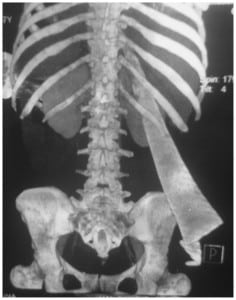| Author | Affiliation |
|---|---|
| Marcello Picchio, MD | Department of Surgery, Civil Hospital “P. Colombo”, Rome, Italy |
| Onofrio Rinaldi, MD | AffilDepartment of Surgery, Civil Hospital “S. Paolo”, Naples, Italyation |
| Antonio Sfarzo, MD | Department of Surgery, Civil Hospital “S. Paolo”, Naples, Italy |
| Domenico Palimento, MD | Department of Surgery, Civil Hospital “S. Paolo”, Naples, Italy |
| Francesco De Angelis, MD | Department of Surgery, University of Rome “La Sapienza”, Latina, Italy |
| Erasmo Spaziani, MD | Department of Surgery, University of Rome “La Sapienza”, Latina, Italy |
A 47-year-old woman presented with a history of an accidental fall against a glass door at home, causing a 15 cm-wide wound on the right gluteal region and hematuria. General health was good: blood pressure 115/70 mmHg with a heart rate of 100 beats/min; red cell count 4.460 x103/100 mL; hemoglobin concentration 10 g/100 ml; and hematocrit 31%.
Computed tomography of the thorax and abdomen (Figure) showed the presence of a foreign body penetrating the right gluteal region and extending along the retroperitoneum. The object had passed across the entire longitudinal diameter of the right kidney. A concomitant retroperitoneal hematoma in the right perirenal space and pelvis was present.

At emergency laparotomy a 25cm piece of glass was extracted from the gluteal wound after right nefrectomy and suture of a 2 cm laceration of the suprarenal inferior vena cava.
The postoperative course was uneventful.
Impalement injuries are rare and may occur either as a result of fall or collision of the human body against an immobile object or by means of a mobile object penetrating a stationary subject. They often pose particular challenges in surgical management. Mortality for penetrating abdominal vena cava injury is 36%–66%.1 Admission hypotension, suprarenal vena cava injuries and association with other visceral and/or other major vascular injuries are predictive of mortality.2
Footnotes
Supervising Section Editor: Sean Henderson, MD
Submission history: Submitted May 2, 2010; Accepted May 10, 2010
Full text available through open access at http://escholarship.org/uc/uciem_westjem
Address for Correspondence: Marcello Picchio, MD, Via Giulio Cesare 58, 04100, Latina, Italy, Telephone: +39773695488
E-mail: marcello.picchio.63@alice.it
Conflicts of Interest: By the WestJEM article submission agreement, all authors are required to disclose all affiliations, funding sources, and financial or management relationships that could be perceived as potential sources of bias. The authors disclosed none.
REFERENCES
1. Hansen CJ, Bernadas C, West MA, et al. Abdominal vena caval injuries: outcomes remain dismal.Surgery. 2000;128:572–8. [PubMed]
2. Kuehne J, Frankhouse J, Modrall G, et al. Determinants of survival after inferior vena cava trauma.Am Surg. 1999;65:976–81. [PubMed]


